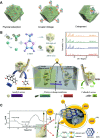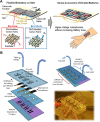Recent advances in enzymatic biofuel cells enabled by innovative materials and techniques
- PMID: 37933234
- PMCID: PMC10624391
- DOI: 10.1002/EXP.20220145
Recent advances in enzymatic biofuel cells enabled by innovative materials and techniques
Abstract
The past few decades have seen increasingly rapid advances in the field of sustainable energy technologies. As a new bio- and eco-friendly energy source, enzymatic biofuel cells (EBFCs) have garnered significant research interest due to their capacity to power implantable bioelectronics, portable devices, and biosensors by utilizing biomass as fuel under mild circumstances. Nonetheless, numerous obstacles impeded the commercialization of EBFCs, including their relatively modest power output and poor long-term stability of enzymes. To depict the current progress of EBFC and address the challenges it faces, this review traces back the evolution of EBFC and focuses on contemporary advances such as newly emerged multi or single enzyme systems, various porous framework-enzyme composites techniques, and innovative applications. Besides emphasizing current achievements in this field, from our perspective part we also introduced novel electrode and cell design for highly effective EBFC fabrication. We believe this review will assist readers in comprehending the basic research and applications of EBFCs as well as potentially spark interdisciplinary collaboration for addressing the pressing issues in this field.
Keywords: bioelectrodes; biosensors; enzymatic biofuel cells; enzyme cascade; implanted devices; metal‐organic frameworks; single enzyme biofuel cells.
© 2023 The Authors. Exploration published by Henan University and John Wiley & Sons Australia, Ltd.
Conflict of interest statement
The authors declare no conflicts of interest.
Figures















Similar articles
-
Recent Advances in Enzymatic Biofuel Cells to Power Up Wearable and Implantable Biosensors.Biosensors (Basel). 2025 Mar 28;15(4):218. doi: 10.3390/bios15040218. Biosensors (Basel). 2025. PMID: 40277532 Free PMC article. Review.
-
A review: Evolution of enzymatic biofuel cells.J Environ Manage. 2021 Nov 15;298:113483. doi: 10.1016/j.jenvman.2021.113483. Epub 2021 Aug 12. J Environ Manage. 2021. PMID: 34391107 Review.
-
Enzymatic Biofuel Cells on Porous Nanostructures.Small. 2016 Sep;12(34):4649-61. doi: 10.1002/smll.201600906. Epub 2016 Jul 5. Small. 2016. PMID: 27377976 Review.
-
Miniaturized Microfluidic Electrochemical Biosensors Powered by Enzymatic Biofuel Cell.Biosensors (Basel). 2023 Jan 22;13(2):175. doi: 10.3390/bios13020175. Biosensors (Basel). 2023. PMID: 36831941 Free PMC article. Review.
-
Enzymatic biofuel cells based on protein engineering: recent advances and future prospects.Biomater Sci. 2020 Sep 30;8(19):5230-5240. doi: 10.1039/d0bm00925c. Biomater Sci. 2020. PMID: 32845259 Review.
Cited by
-
The role of 3D printing in skeletal muscle-on-a-chip models: Current applications and future potential.Mater Today Bio. 2025 Aug 20;34:102222. doi: 10.1016/j.mtbio.2025.102222. eCollection 2025 Oct. Mater Today Bio. 2025. PMID: 40917517 Free PMC article.
-
Fueling the Future: The Emergence of Self-Powered Enzymatic Biofuel Cell Biosensors.Biosensors (Basel). 2024 Jun 24;14(7):316. doi: 10.3390/bios14070316. Biosensors (Basel). 2024. PMID: 39056592 Free PMC article. Review.
-
Development of a Predictive Model for Evaluation of the Influence of Various Parameters on the Performance of an Oscillating Water Column Device.Sensors (Basel). 2024 Jun 1;24(11):3582. doi: 10.3390/s24113582. Sensors (Basel). 2024. PMID: 38894373 Free PMC article.
-
Dimensional Fidelity and Orientation Effects of PolyJet Technology in 3D Printing of Negative Features for Microfluidic Applications.Micromachines (Basel). 2024 Mar 13;15(3):389. doi: 10.3390/mi15030389. Micromachines (Basel). 2024. PMID: 38542637 Free PMC article.
-
Unlocking the Potential of MBenes in Li/Na-Ion Batteries.Molecules. 2025 Jul 1;30(13):2831. doi: 10.3390/molecules30132831. Molecules. 2025. PMID: 40649345 Free PMC article. Review.
References
-
- Davis F., Higson S. P., Biosens. Bioelectron. 2007, 22, 1224. - PubMed
-
- Lamy C., Lima A., LeRhun V., Delime F., Coutanceau C., Léger J.‐M., J. Power Sources 2002, 105, 283.
-
- Cheng X., Shi Z., Glass N., Zhang L., Zhang J., Song D., Liu Z.‐S., Wang H., Shen J., J. Power Sources 2007, 165, 739.
-
- Cooney M., Svoboda V., Lau C., Martin G., Minteer S. D., Energy Environ. Sci. 2008, 1, 320.
-
- a) Palmore G. T. R., Whitesides G. M., ACS Symp. Ser. 1994, 566, 271;
- b) Potter M. C., Proc. R. Soc. London, Ser. B 1911, 84, 260.
Publication types
LinkOut - more resources
Full Text Sources
Research Materials
Miscellaneous
